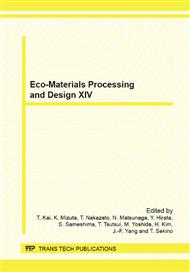p.35
p.41
p.49
p.55
p.59
p.65
p.69
p.73
p.79
Fabrication and Characterization of Calcium Silicate Phosphors - Ca2SiO4 and Ca2MgSi2O7 -
Abstract:
Calcium silicate phosphors, Ca2-xSiO4(CS):Eu3+x, CS:Eu2+x and Ca2-y-zMgSi2O7 (CMS):Eu2+y,Dy3+z were prepared by the solid state reaction. The phases in CS:Eu3+ system were β- and αL’ -types. The fluorescent color under a black-light irradiation was red and the emission spectrum consisted of 590nm(αL’), 615nm(β) and 625nm(αL’) peaks. The emission intensity took a maximum value at x=0.2. The addition of B3+ accelerated the solid solution of Eu3+. The phase in CS:Eu2+ system was β-type only. The fluorescent color was yellow-green(520nm). The emission intensity took a maximum value at x=0.01. The CMS product showed the akermanite phase. The lattice constants of CMS:Eu2+ increased with increasing Eu content, but those became constant at y>0.05. The fluorescent color of CMS:Eu2+ was yellow-green and the emission intensity took a maximum value at y=0.03. In the case of CMS:Eu2+0.03,Dy3+z, the fluorescent color and the afterglow color were same, yellow-green. The emission intensity took a maximum value at z=0.06. The longest afterglow time, 23min., was obtained at z=0.09. The trap depth were 0.64-0.69 eV.
Info:
Periodical:
Pages:
59-64
Citation:
Online since:
July 2013
Price:
Сopyright:
© 2013 Trans Tech Publications Ltd. All Rights Reserved
Share:
Citation:


